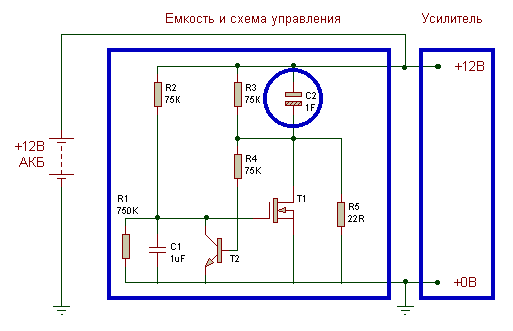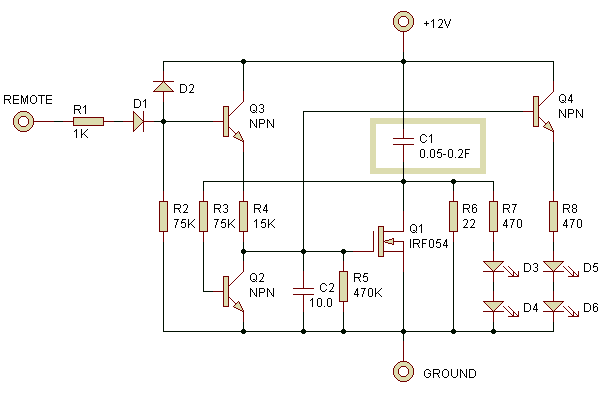
(c) klausmobile 2000
One-farad capacitors require some care. It's a common knowledge that they must be pre-charged with a current-limiting resistor before plugging in. It is less common knowledge that those fifty-dollar 'smart cap controllers' are in fact very simple devices, two dollars for parts and labor. Here's a basic cap switch that will connect capacitor to ground only when it's charged to within 0.4-0.7V from battery voltage (otherwise, it's charging through a 22 Ohm resistor, which can be a low-power 12V lightbulb, too).

Note that when the circuit is open, and a high current draw starts dicharging the capacitor, T1 (N-MOS with low channel resistance - IRF1010, IRFP054, IRF048, P60N06 etc) is actually conducting in reverse direction (as in syncronous rectifiers: S->D not D->S). This is OK for a fully open MOS FET. The circuit could be built on P-channek devices too but they are inherently worse conductors than N-channels.
Such a cheap, simple circuit needs no heatsink. Just parallel as many FETs as necessary (with a common gate control network). Given amplifier (AB class) useful output P /Watts/ and each FET's Rds /Ohms/, and 1 Watt maximum heat dissipation for each, number of transistors N>=1/6 * P * sqrt (Rds). Practically, it is safe to cut N 2-3 times, so minimum N>=1/15 * P * sqrt(Rds). That is, one IRF1010 with maximum (hot) Rds of 0.020 Ohms, can safely serve a 120W output amplifier. Commercial controllers rely on many (some as many as 18 devices) small dirt-cheap transistors in D2 or MiniDIP cases, each dissipating up to 0.3-0.5W. Some of them have Rds actually better than the best devices in 'large' TO220 and TO247 cases.
A step further is to disable capacitor discharge when REMOTE control signal is low. The simplest solution is to power all gate control circuitry from the REMOTE wire, or - better - with a follower. LEDs D3-D4 indicate charge, D5-D6 - switch is open. 0.2F capacitor value shown is for example only - that's enough assuming a single transistor serves a 120W amp.

Power loss in the switch depends on the FET's Rds, and even more - on wiring. Thin, inefficient power wiring can leave the whole device useless. DO NOT rely on PCB copper - use thick, at least 2 sq.mm. copper litz wire. For a DIY install, forget fancy terminals and hard-solder short AWG8 wires that will connect to amp and distributor box.
Index in English - Index in Russian - Mail